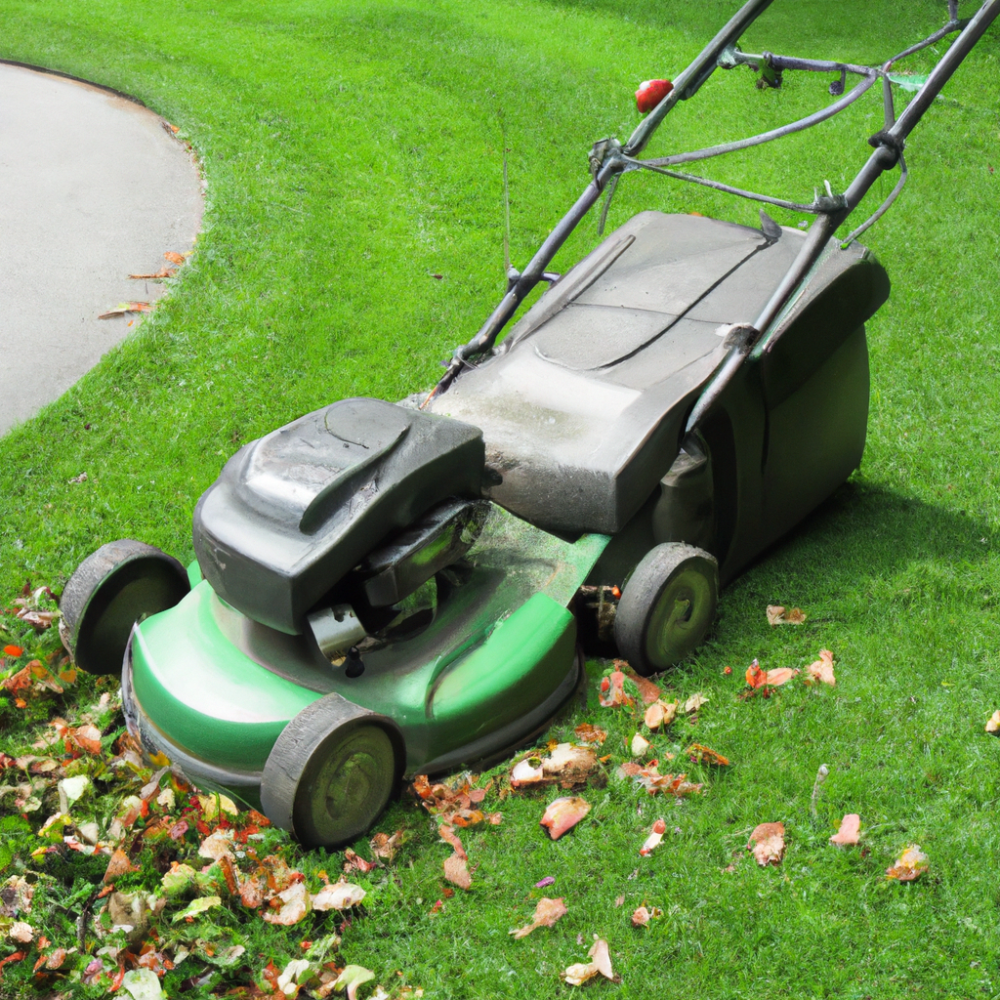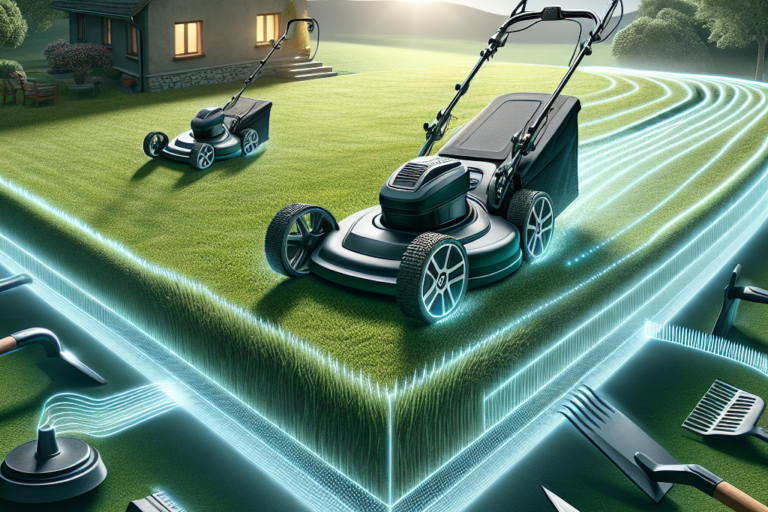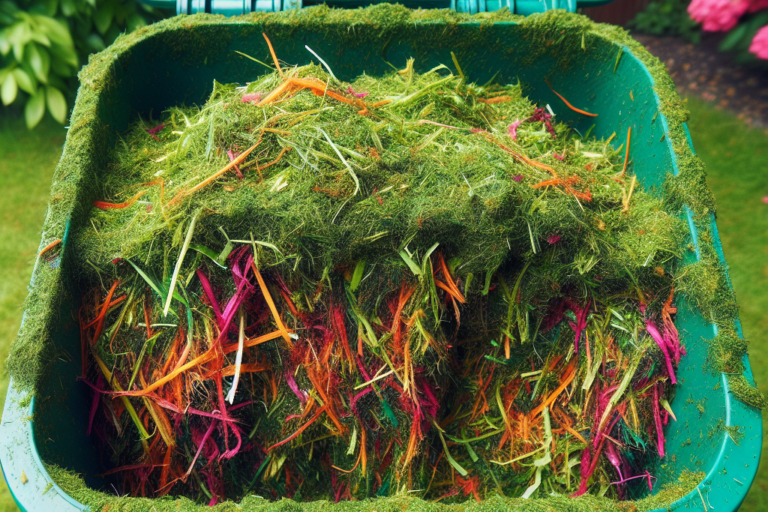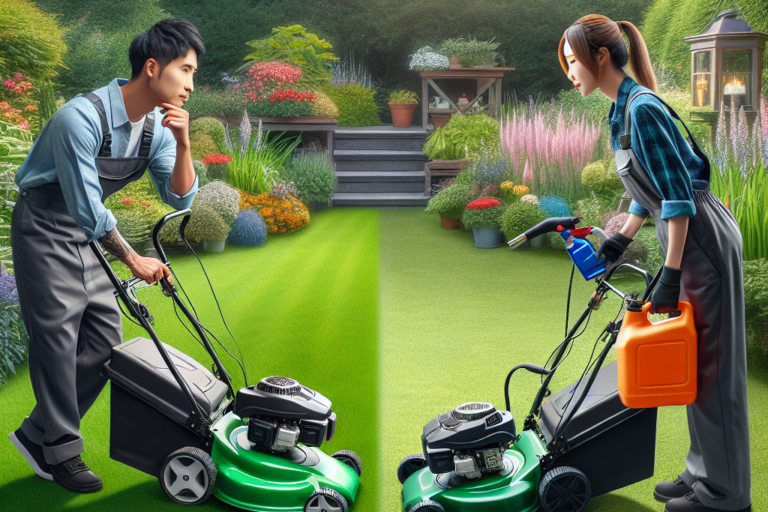If you’re wondering whether your trusty electric lawn mower can also handle the task of leaf mulching, you’re in the right place! In this article, we’ll explore the potential of electric lawn mowers for this green, time-saving technique. From understanding the benefits of leaf mulching to discovering the capabilities of electric lawn mowers, we’ll provide you with all the information you need to make an informed decision. So, let’s dive in and see if your electric lawn mower is up to the leaf mulching challenge!
Overview of electric lawn mowers
Electric lawn mowers are a popular choice for homeowners who want a convenient and eco-friendly way to maintain their lawns. These mowers are powered by electricity, either through a cord or a battery, and offer several advantages over traditional gas-powered mowers. They are generally lighter, quieter, and easier to operate, making them a great option for people of all ages and physical abilities.
Definition and components of electric lawn mowers
Electric lawn mowers are machines that use electricity as their power source to cut grass and maintain a neat and tidy lawn. They consist of several components, including a cutting deck, a motor, and a handle with controls. The cutting deck, typically made of durable metal, houses the blades that do the actual grass cutting. The motor generates the power needed to rotate the blades and propel the mower forward. The handle contains the controls for starting and stopping the mower, as well as adjusting its height and speed.
Advantages and disadvantages compared to gas-powered mowers
Electric lawn mowers offer several advantages over their gas-powered counterparts. Firstly, they are more environmentally friendly since they produce zero emissions during operation. This makes them a greener choice for those who are conscious of their carbon footprint. Additionally, electric mowers are generally quieter during use, which can be beneficial for those living in suburban neighborhoods or areas with noise restrictions.
Another advantage of electric mowers is their lower maintenance requirements. Unlike gas-powered mowers that require regular oil changes, spark plug replacements, and air filter cleanings, electric mowers are often maintenance-free. They also eliminate the need for storing and handling gasoline, reducing the risk of accidental spills or leaks.
However, electric mowers do have some disadvantages to consider. Their run time is often limited by the battery life or cord length, which may require multiple sessions or recharging for larger lawns. Electric mowers may also have less cutting power compared to gas-powered mowers, especially when dealing with overgrown or tough grass. It’s important to assess your specific lawn care needs before deciding if an electric mower is right for you.
Leaf mulching
Leaf mulching is a practice that involves shredding leaves into small pieces and spreading them over the lawn. This process helps the leaves break down more quickly, providing valuable nutrients to the soil and reducing the need for bagging and disposal.
Definition and benefits of leaf mulching
Leaf mulching is a natural and sustainable way to manage fallen leaves in the yard. Instead of raking and bagging them, the leaves are finely chopped into smaller pieces, allowing them to decompose more easily. This process has numerous benefits for the lawn and the environment.
One of the key advantages of leaf mulching is that it replenishes the soil with organic matter. As the mulched leaves break down, they release essential nutrients back into the soil, enriching it and promoting healthier grass growth. This natural fertilization reduces the dependence on synthetic fertilizers, which can be harmful to the environment.
Additionally, leaf mulching helps retain moisture in the soil, acting as a natural moisture barrier. The mulched leaves create a protective layer over the lawn, reducing water evaporation and conserving moisture. This is especially beneficial during drier periods or in regions that experience water restrictions.
Traditional methods of leaf mulching
Before the introduction of electric lawn mowers, manual methods were commonly used for leaf mulching. Rakes and leaf blowers were the primary tools for collecting and shredding leaves. However, these methods were often time-consuming and physically demanding, especially for larger yards with an abundance of leaves.
Raking involved manually gathering the leaves into piles and then using a rake or tarp to transport them to a designated area for shredding. Leaf blowers provided a more efficient way to gather leaves, but still required manual bagging or hauling of the leaves to a disposal area.
While these traditional methods can still be employed, electric lawn mowers have revolutionized the process, making it faster, easier, and more efficient. With the right equipment and techniques, electric mowers can effectively and efficiently mulch leaves, eliminating the need for labor-intensive manual methods.

Compatibility of electric lawn mowers with leaf mulching
Electric lawn mowers are compatible with leaf mulching, and many models are specifically designed to handle this task effectively. However, there are certain factors to consider when choosing an electric mower for leaf mulching and ensuring optimal performance.
Mulching blades and their role in electric mowers
Mulching blades are an essential component of electric mowers used for leaf mulching. These specialized blades are designed with a unique shape and cutting edge that allows them to efficiently shred leaves into smaller pieces. Unlike standard blades that simply cut and discharge grass clippings, mulching blades are designed to create a fine mulch, promoting faster decomposition and nutrient absorption by the soil.
When selecting an electric mower for leaf mulching, it’s important to ensure that it is equipped with mulching blades. These blades are usually included with the mower when purchased, but can also be purchased separately as an accessory for some models. The manufacturer’s specifications or product description will provide details on whether mulching blades are included.
Efficiency of electric mowers for leaf mulching
Electric mowers are highly efficient for leaf mulching due to their cutting power and mulching capabilities. The sharp mulching blades, coupled with the powerful motor, enable electric mowers to effectively shred leaves into small pieces while still maintaining an even cutting height.
One advantage of electric mowers over gas-powered mowers for leaf mulching is their ability to maintain a consistent speed and cutting performance. Gas mowers may experience fluctuations in power as the fuel level decreases, affecting the mulching quality. Electric mowers, on the other hand, provide consistent power throughout the mowing process, ensuring consistent and efficient leaf mulching.
The efficiency of electric mowers for leaf mulching also depends on the mower’s cutting deck size. Larger cutting decks accommodate more leaves in a single pass, reducing the time and effort required to cover the entire lawn. However, even smaller electric mowers can effectively mulch leaves with multiple passes.
Types of electric lawn mowers suitable for leaf mulching
Electric lawn mowers come in two main types – corded electric mowers and battery-powered mowers. Both types are suitable for leaf mulching, and the choice between them depends on individual preferences and yard size.
Corded electric mowers
Corded electric mowers are powered by electricity through a cord that connects to an electrical outlet. These mowers provide consistent and uninterrupted power, making them a reliable choice for small to medium-sized lawns. They offer the advantage of unlimited runtime, as long as the cord can reach the desired areas.
One consideration when using corded electric mowers for leaf mulching is the need to manage the cord effectively. The cord must be kept clear of obstacles and sharp objects to avoid damage or tripping hazards. Additionally, an outdoor-rated extension cord may be necessary to extend the reach of the mower, depending on the size of the lawn.
Battery-powered electric mowers
Battery-powered electric mowers, as the name suggests, are powered by a rechargeable battery. These mowers offer the advantage of cordless operation, providing more freedom of movement and eliminating the risk of accidentally cutting the cord. They are a popular choice for larger lawns or areas where access to electrical outlets is limited.
When using battery-powered mowers for leaf mulching, it is important to consider the battery life and capacity. The runtime of the mower will depend on the battery’s charge, and larger lawns may require multiple charges or extra batteries to complete the mulching process. It is advisable to have a backup battery or a spare charged to ensure uninterrupted operation.
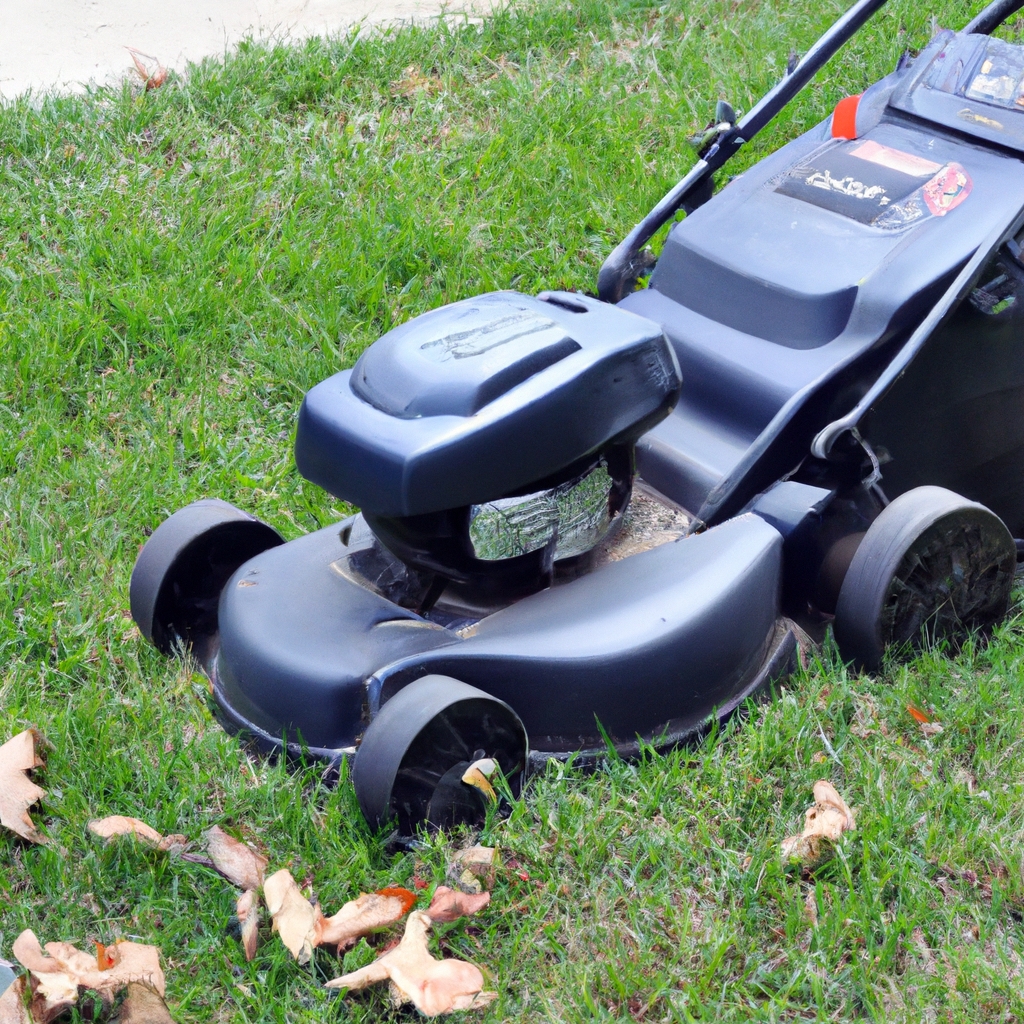
Considerations for using electric lawn mowers for leaf mulching
While electric mowers are well-suited for leaf mulching, there are several important considerations to keep in mind to achieve optimum results. These considerations include leaf size and thickness, moisture content of leaves, and frequency of leaf collection.
Leaf size and thickness
Electric mowers are generally capable of mulching leaves of various sizes and thicknesses. However, larger and thicker leaves may require more passes or additional shredding to achieve the desired mulching effect. It is important to avoid overwhelming the mower by attempting to mulch an excessive amount of leaves at once. Mulching in smaller increments will ensure better results and prevent strain on the mower’s motor.
To further assist the mulching process, it can be helpful to mow over the leaves when they are slightly dry. This allows the leaves to be more easily shredded without clumping or clogging the cutting deck.
Moisture content of leaves
The moisture content of leaves can greatly impact the mulching process with electric mowers. Leaves that are overly wet or damp can clump together, making it more challenging for the mower to effectively shred them. This can result in uneven mulching and potential clogs in the cutting deck.
It is best to mulch leaves when they are dry or slightly damp. If the leaves are wet from rain or dew, it may be necessary to allow them to dry out or use a leaf blower to remove excess moisture before mulching. This will ensure the leaves are properly shredded and distributed across the lawn.
Frequency of leaf collection
The frequency of leaf collection will also influence the effectiveness of leaf mulching with electric mowers. Regularly mulching leaves as they fall, rather than allowing them to accumulate in large quantities, will yield better results.
By mulching leaves frequently, the mower can process smaller amounts of leaves at a time, resulting in finer mulch and better distribution. Waiting until the leaves have piled up too high can make it more challenging for the mower to effectively mulch them and may require additional passes or adjustments to ensure thorough coverage.
Steps for effective leaf mulching with electric mowers
To achieve effective leaf mulching with an electric mower, there are several key steps to follow. These steps include proper preparation of the mowing area, adjusting the mower deck height, using an appropriate mowing technique, and completing post-mowing clean-up.
Preparation of the mowing area
Before starting the mulching process, it is important to clear the lawn of any debris or obstacles that may interfere with the mower’s operation. Remove any branches, rocks, or large sticks that could damage the blades or cause the mower to become stuck. Inspect the area for any potential hazards and ensure the lawn is clear and ready for mulching.
Adjusting the mower deck height
To achieve optimal mulching results, it is crucial to adjust the mower’s cutting deck height appropriately. Set the cutting deck to a height that allows the blades to come into contact with the leaves without cutting the grass too short. Ideally, the blades should be positioned to finely shred the leaves without scalping the lawn. Consult the mower’s manual or follow the manufacturer’s instructions for adjusting the cutting deck height.
Appropriate mowing technique
When mulching leaves with an electric mower, it is important to use the appropriate mowing technique. Instead of mowing in straight lines, consider using a slightly overlapping zigzag pattern to ensure even distribution of the mulched leaves. This technique helps prevent clumping and ensures consistent mulching across the entire lawn.
To achieve the best results, mow at a steady pace and avoid rushing. This allows the mower to effectively shred the leaves and ensures thorough coverage. If the leaves are not being mulched adequately, consider making additional passes in the affected areas.
Post-mowing clean-up
After completing the mulching process, it is important to clean up any remaining debris or excess mulch. Use a leaf blower or rake to gather any clumps of mulched leaves that may have accumulated on the lawn. This will prevent them from matting or smothering the grass and allow for better absorption into the soil.
Dispose of any excess mulch appropriately, such as composting or using it as a natural ground cover in other areas of the yard. Proper clean-up ensures a neat and tidy lawn while maximizing the benefits of leaf mulching.
Maintenance and care for electric mowers used in leaf mulching
Proper maintenance and care are essential for keeping electric mowers in optimal condition when used for leaf mulching. Following these maintenance guidelines will help prolong the life of the mower and ensure reliable performance.
Cleaning the mower after use
After each use, it is important to clean the mower to remove any grass clippings, debris, or mulch residue. Disconnect the power source and safely tilt the mower on its side or use a brush to remove debris from the cutting deck and blades. Avoid using water when cleaning the mower, as moisture can damage the electrical components. Ensure the mower is completely dry before storing it.
Sharpening and replacing blades
Mulching blades can become dull over time, especially when used extensively for leaf mulching. It is important to regularly inspect the blades for signs of wear or damage and sharpen or replace them as needed. Dull blades can lead to poor mulching performance and may strain the mower’s motor. Consult the manufacturer’s recommendations for the appropriate sharpening or replacement schedule.
Battery maintenance (for battery-powered mowers)
If using a battery-powered mower, proper battery maintenance is crucial for maintaining optimal performance. Follow the manufacturer’s instructions for charging and storing the battery. Avoid overcharging or discharging the battery excessively, as this can shorten its lifespan. If the battery shows signs of deterioration or fails to hold a charge, it may need to be replaced.
Tips for maximizing leaf mulching with electric mowers
To maximize the benefits of leaf mulching with electric mowers, consider implementing the following tips:
Avoiding wet or damp leaves
Mulching wet or damp leaves can lead to clumping and clogging in the cutting deck. For best results, wait until the leaves are dry or slightly damp before mulching. If necessary, use a leaf blower to remove excess moisture from the leaves before mowing.
Mulching in small increments
Rather than waiting for a large accumulation of leaves, mulch the leaves in smaller increments as they fall. This prevents overwhelming the mower and ensures better results. Regular mulching also promotes faster decomposition of the leaves and provides more consistent nutrient release for the soil.
Using a mulching plug or attachment
Some electric mowers come with a mulching plug or attachment that enhances the mulching process. These accessories help contain the shredded leaves within the cutting deck, allowing for more effective and efficient mulching. If your mower does not include a mulching plug or attachment, check with the manufacturer to see if one is available as an accessory.
Environmental impact of electric lawn mowers for leaf mulching
Using electric lawn mowers for leaf mulching offers several environmental benefits compared to alternative methods of leaf disposal. These benefits include the reduction of waste and landfill use, lower greenhouse gas emissions, and reduced noise pollution.
Reduction of waste and landfill use
By mulching leaves directly into the lawn, electric mowers eliminate the need for bagging and disposing of leaves in landfill sites. This reduces the amount of organic waste that ends up in landfills, where it contributes to greenhouse gas emissions as it decomposes. Leaf mulching with electric mowers allows leaves to be recycled back into the lawn, providing valuable nutrients and organic matter to support healthy soil and plant growth.
Lower greenhouse gas emissions
Electric mowers produce zero emissions during operation, unlike gas-powered mowers that emit pollutants and greenhouse gases. The use of electric mowers for leaf mulching helps reduce the carbon footprint associated with lawn care, contributing to cleaner air and a healthier environment. This can be especially beneficial in urban areas where air quality is a concern.
Reduced noise pollution
Electric mowers are generally quieter during operation compared to gas-powered mowers. This reduces noise pollution, minimizing disturbances to the neighborhood or the tranquility of the yard. The quieter operation of electric mowers allows for more flexible mowing times, including early morning or late evening, without inconveniencing others.
Conclusion
Electric lawn mowers are a practical and environmentally friendly choice for maintaining a well-manicured lawn. Their compatibility with leaf mulching makes them even more attractive, providing homeowners with an efficient and sustainable method for managing fallen leaves. With the appropriate equipment, techniques, and considerations, electric mowers can effectively mulch leaves, promoting healthier lawns and reducing waste. Whether opting for a corded electric mower or a battery-powered one, homeowners can enjoy the benefits of mulching while contributing to a greener and more sustainable environment.
